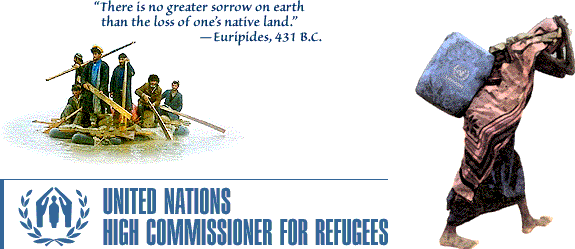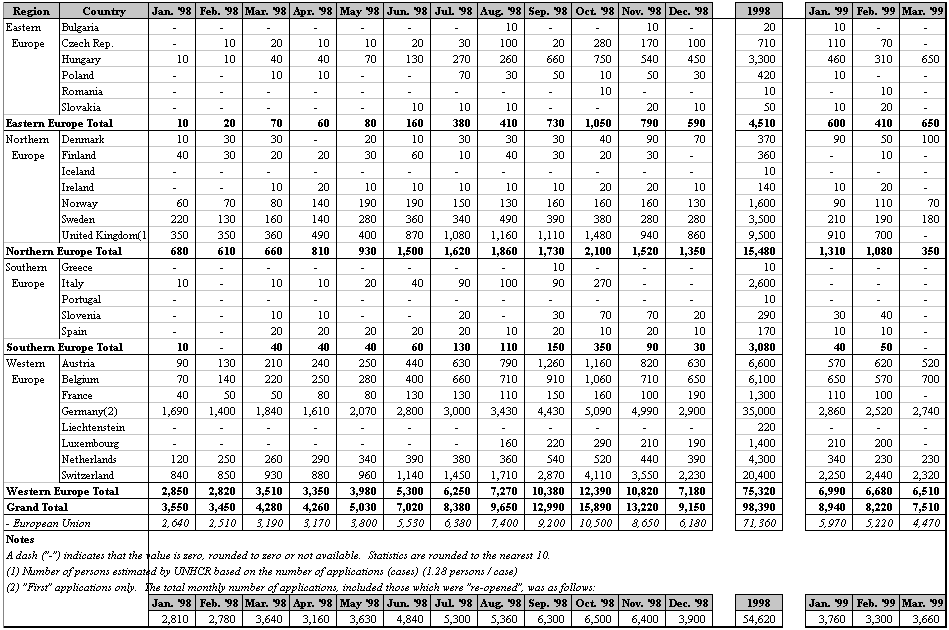| 13 April 1999 |
|
AT A GLANCE
- New refugee influx into Albania in the early morning hours
of 13 April (see Table 1 below for UNHCR estimated figures as at 14 April 1999, 08:00
GMT)
- Very few refugees arrive in Macedonia (FYROM).
- Around 1,300 refugees were evacuated from Macedonia by air
on Monday to Germany, Israel, Norway and Turkey, bringing the total moved out of Macedonia
by air to 9,300.
MAJOR DEVELOPMENTS
ALBANIA
There was a new influx of refugees at the Morini border
between midnight and 5:00 a .m. on Tuesday. An estimated 4,800 refugees crossed into
Albania, mainly driving tractors pulling wagons. Most of the refugees came from two
villages in Kosovo Polje municipality, Velika Slatina and Mala Slatina. They said they had
been ordered by police to leave for Albania but as they had been expecting to be expelled
for some time, they were able to prepare some belongings in advance.
Several hundred of the refugees came from Orahovac
municipality (Zrze village). They told UNHCR they were part of the queue of refugees which
had been turned back from the border in the first week of April. They had been ordered at
that time by police to return to their homes which were still intact. They stayed in their
village until the morning of 12 April, when police ordered them to leave. They were not
physically mistreated, they said, but were stripped of their money and identity documents.
Twenty vehicles and their passengers remained behind.
Earlier on Monday 12 April around 100 refugees passed
through the Morini border crossing. These refugees said that they fled their village in
Orahovac district three weeks ago, when it was attacked and set on fire, and they had been
hiding in the forest since then. They believed that some 75 villagers had perished in the
fire. Most of these refugees said they had been waiting to cross the border on 7 April,
when they were turned back by Yugoslav security forces. They went to Prizren, where they
occupied an abandoned apartment building. Without explanation, the police appeared on
Sunday, 12 April, and ordered them to leave by midnight or be killed.
A convoy carrying plastic sheeting arrived in Kukes from
Tirana on Monday, and humanitarian rations came by helicopter.
Refugees in Albania are mainly located in the following
prefectures: Kukes, Has, Tirana, Durres, Fier, Shkoder, Korca, and Elbasan. About 80% of
the refugees in Albania are accommodated by local families and UNHCR is working to assist
both host families as well as refugees.
MACEDONIA (FYROM)
Approximately 440 refugees arrived in Blace around noon on
Monday, and were taken to the Brazda camp by bus. The refugees said they were put on a
train in Urosevac and were let off on the Yugoslav side of the border which they then had
to cross on foot. The train ride was "confusing and frightening" they said,
because they were harassed by hostile crowds and volleys of gunfire and the train kept
jolting backwards and forwards. It wasn’t until the end of the journey that they
realized they were at the border with Macedonia. Though they boarded the train at Urosevac
many refugees said they had been moving from one village to another for the past week.
UNHCR is nearing completion of the registration of the
population at the Brazda camp and has started registration at the Stankovic site. UNHCR
intends to finish registration of all refugees staying in camps in Macedonia (FYROM)
within two weeks.
UNHCR and government authorities in Skopje have been
discussing contingency planning and agreed to identify new sites for refugee camps which
may be needed, depending on developments. Meanwhile preparations for the handover to UNHCR
and its partners of the sites currently run by NATO are proceeding well, and should be
completed shortly. NGOs will take over the assistance programs which in the initial phase
have been handled by NATO.
During the weekend, UNHCR was given access for the first
time to the Radusa refugee camp, which is managed by the Macedonian authorities. A site
assessment was carried out, and the location was found to have serious drainage problems.
Discussions with the authorities have begun to resolve this issue.
HUMANITARIAN EVACUATION
On Monday UNHCR coordinated the evacuation of just over
1,300 refugees from Macedonia to Germany, Israel, Norway and Turkey. The refugees
evacuated to Israel were mainly special medical cases who were treated initially in the
Israeli field hospital in Brazda camp. The total number of refugees evacuated so far since
the airlift began on 7 April is 9,300. This includes around 2,000 evacuated in bilateral
arrangements between Macedonia and Turkey, before UNHCR/IOM co-ordination of the airlift
began (see Table 2 below).
Another 8 flights, carrying around 1,300 refugees, are
expected to take place on Tuesday 13 April.
SEPARATED CHILDREN
UNHCR is receiving many enquiries from people around the
world wanting to adopt unaccompanied refugee children. At this stage, no Kosovar refugee
children are available for adoption. While some children have been separated from their
families during their flight, they are not necessarily orphans. UNHCR, UNICEF, ICRC and
other agencies are giving top priority to tracing family members of separated children,
and to the reunification of these children with their families.
|
|
|
|
|
Table 1: Daily
Population Estimates
| Refugees/Displaced in: |
Remarks |
Total
|
Federal Republic of
Yugoslavia
(Republic of Mongenegro) |
| • |
New arrivals from Istok and Vrelo on April
13. Several hundred departures for northern Albania |
| • |
No figures for displacement within Kosovo
available. |
| • |
Yugoslav government report of 50,000 in
Serbia unconfirmed |
|
67,200 |
| Former Yugoslav Republic
of Macedonia (FYROM) |
| • |
Departures April 13 ca. 1,400 by air. Arrivals ca. 750 |
|
116,000 |
| Albania |
| • |
No significant number of arrivals during day
of April 13 |
|
314,300 |
| Bosnia and Herzegovina |
| • |
Includes Kosovo Albanians, Serbs and Muslim Slavs from
Sandzak. Arrivals April 13 ca. 300 from Sandzak |
|
27,700 |
| TOTAL |
|
525,200
|
Table 2: Humanitarian evacuations of Kosovar
refugees
from Macedonia (FYROM) from April 5 through April 13
(figures subject to daily verification)
| Receiving Country |
Arrivals
|
13 April
|
Total |
| Germany |
1,256 |
6,690 |
| Iceland |
--- |
23 |
| Israel |
--- |
106 |
| Norway |
108 |
725 |
| Poland |
--- |
60 |
| Switzerland |
--- |
13 |
| Turkey |
65 |
3,163 * |
| TOTAL |
1,429 |
10,780 * |
* of whom 1,980 without UNHCR/IOM involvement
(source: Turkish government)
Table 3: Asylum applications lodged by citizens of the
Federal Republic of Yugoslavia during
1998 and 1999 (monthly provisional and annual figures) (updated
12 April 1999)
|



 Document compiled by Dr S D Stein
Document compiled by Dr S D Stein